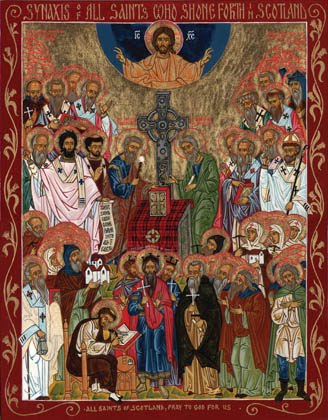Saint Aldhelm (Ealdhelm) was born about the year 639. He is said to have been the son of Kenten, of the royal house of Wessex. He received his education from the Irish monk-scholar Maeldubha, after whom Malmesbury is named. Aldhelm was one of the disciples of Abbot Adrian of Canterbury. His studies included Roman law, astronomy, mathematics, and difficulties of the calendar. He learned Greek and Hebrew. Ill health compelled him to leave Canterbury, and the Saint returned to Malmesbury Abbey, where he was a monk under Maeldubha for 14 years. When Maeldubha reposed, Aldhelm was appointed in 675 to be first abbot of Malmesbury.
Aldhelm introduced the Benedictine rule, and secured the right of the election of the abbot to the monks. The community increased, and Aldhelm was able to found two other monasteries: Frome, Somerset and Bradford on Avon, Wiltshire. The little church of St Laurence at Bradford on Avon (photo below) dates back to his time, and is probably his. At Malmesbury he built a new church and obtained grants of land for the monastery.
Aldhelm introduced the Benedictine rule, and secured the right of the election of the abbot to the monks. The community increased, and Aldhelm was able to found two other monasteries: Frome, Somerset and Bradford on Avon, Wiltshire. The little church of St Laurence at Bradford on Avon (photo below) dates back to his time, and is probably his. At Malmesbury he built a new church and obtained grants of land for the monastery.

His fame as a scholar spread to other countries. Artwil, the son of an Irish king, submitted his writings for Aldhelm's approval, and Cellanus, an Irish monk from Peronne in Gaul, was one of his correspondents. Aldhelm was the first Anglo-Saxon, so far as we know, to write in Latin verse, and his letter to Acircius (Aldfrith or Eadfrith, king of Northumbria) is a treatise on Latin prosody for the use of his countrymen. In this work he included his most famous productions, 101 riddles in Latin hexameters. Each of them is a complete picture, and one of them runs to 83 lines.
His fame as a scholar reached Italy, and at the request of Pope Sergius I, abbot Aldhelm paid a visit to Rome. He was deputed by a synod of the church in Wessex to remonstrate with the Britons of Dumnonia (Devon and Cornwall) on the Easter controversy. British Christians followed a unique system of calculation for the date of Easter and also bore a distinctive tonsure; these customs are generally associated with the practice known as Celtic Christianity. Aldhelm wrote a long and rather acrimonious letter to king Geraint of Dumnonia (Geruntius) achieving ultimate agreement with the Patriarchate (Rome).
In 705, or perhaps earlier, Hedda, bishop of Winchester, reposed, and the diocese was divided into two parts. Sherborne was the new see, of which Aldhelm reluctantly became the first bishop in 705. He wished to resign the abbey of Malmesbury which he had governed for 30 years, but he yielded to the remonstrances of the monks and continued directing it until his death. Though he was now an old man, St. Aldhelm was very active as a Bishop. He built a cathedral church at Sherborne, described by William of Malmesbury. St. Aldhelm was known for singing hymns and passages from the gospels, interspersed with entertaining tales, in public places so that he might draw attention from the crowds and then preach to them. For this, he is known as the Apostle of Wessex.
St. Aldhelm fell asleep in the Lord in the church of Doulting on 25 May 709. His holy and venerable body was taken to Malmesbury, and crosses were set up by his friend, St. Egwin, Bishop of Worcester, at the various stopping-places. The Saint was buried in the church of St. Michael at Malmesbury Abbey (photo below). His biographers relate miracles worked during his lifetime and at his shrine. He was revered as a saint after his death, and his feast on May 25 is found in the Sarum Missal.

Holy Father Aldhelm, pray to God for us
Source: http://www.allmercifulsavior.com/icons/Icons-Aldhelm.htm


No comments:
Post a Comment